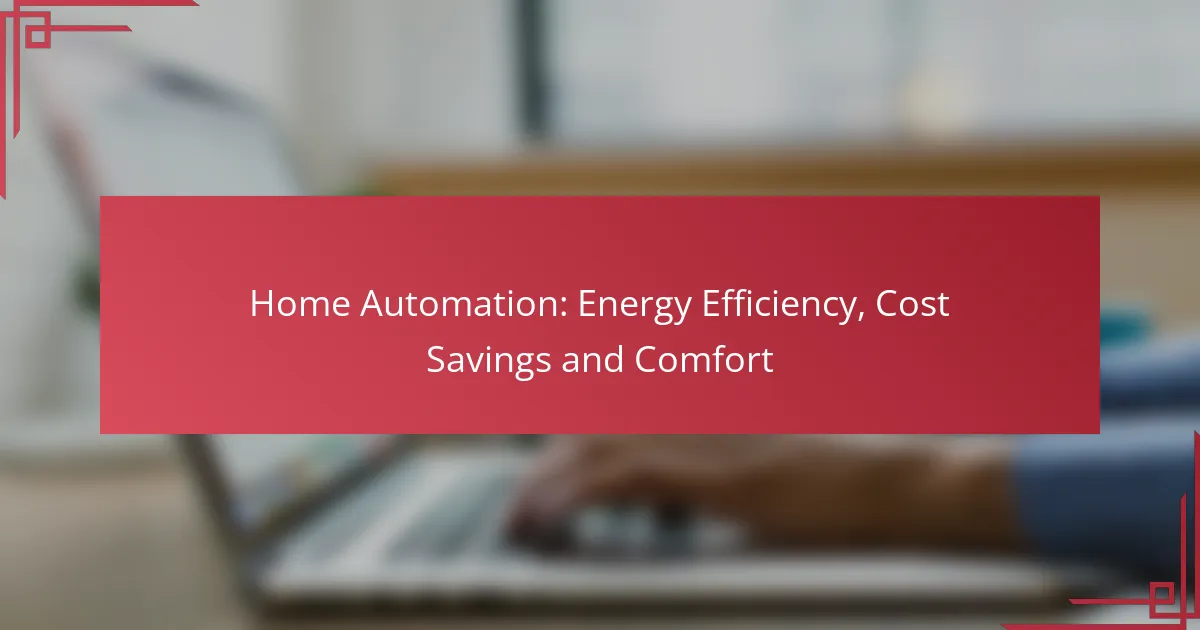Home automation is revolutionizing the way we manage energy consumption, offering significant benefits in energy efficiency, cost savings, and overall comfort. By leveraging smart technology, homeowners can optimize their energy use, reduce utility bills, and create personalized living environments that enhance convenience and enjoyment. This innovative approach not only leads to financial savings but also contributes to a more sustainable future.
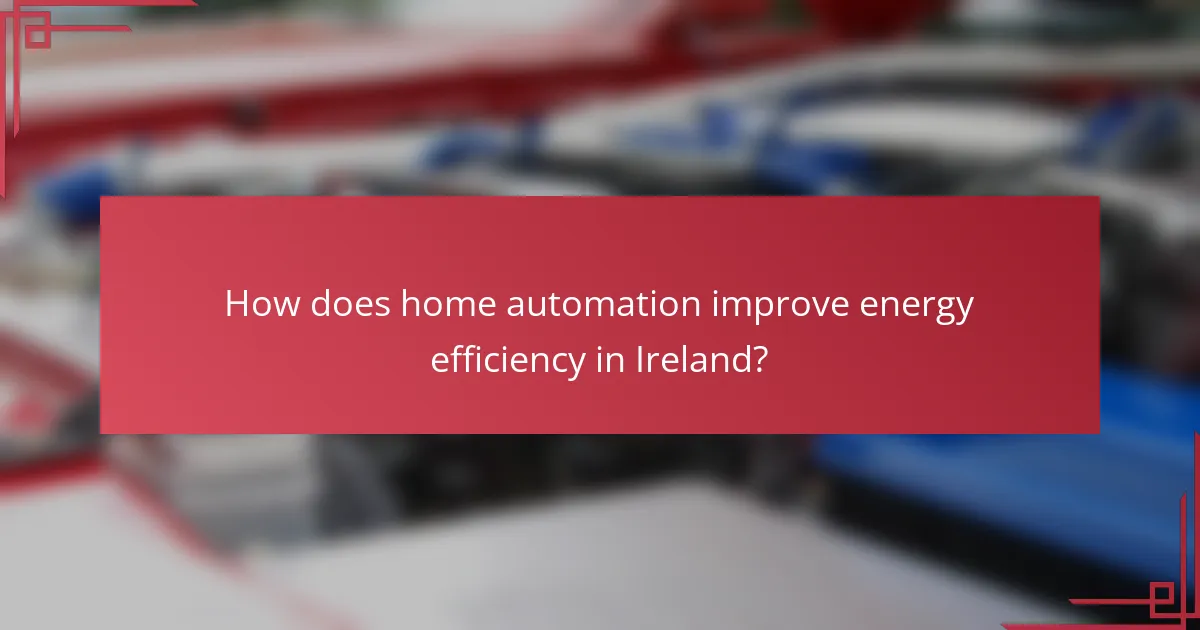
How does home automation improve energy efficiency in Ireland?
Home automation enhances energy efficiency in Ireland by optimizing the use of energy-consuming devices, leading to reduced costs and environmental impact. Through smart technology, homeowners can monitor and control their energy usage more effectively, ensuring that resources are used only when necessary.
Smart thermostats reduce heating costs
Smart thermostats are designed to learn your heating preferences and adjust accordingly, significantly lowering heating costs. By programming schedules or using geofencing, these devices can reduce heating when no one is home, potentially saving up to 20% on energy bills during the colder months.
When selecting a smart thermostat, look for models that are compatible with your heating system and offer features like remote control via smartphone apps. This allows for real-time adjustments, ensuring optimal comfort without unnecessary energy expenditure.
Automated lighting systems minimize energy waste
Automated lighting systems can dramatically cut down on energy waste by ensuring lights are only on when needed. Motion sensors and timers can turn off lights in unoccupied rooms, which is particularly useful in larger homes or commercial spaces.
Consider integrating smart bulbs that can be controlled remotely or set to dim according to the time of day. This not only saves energy but also extends the lifespan of your lighting fixtures, providing additional cost savings over time.
Energy monitoring devices track usage
Energy monitoring devices provide real-time insights into your household’s energy consumption, helping identify areas where savings can be made. By tracking usage patterns, homeowners can make informed decisions about when and how to use energy more efficiently.
Investing in a comprehensive energy monitoring system can help you pinpoint high-energy appliances and adjust usage accordingly. Many devices offer alerts for unusual spikes in energy consumption, allowing for proactive management of energy costs.
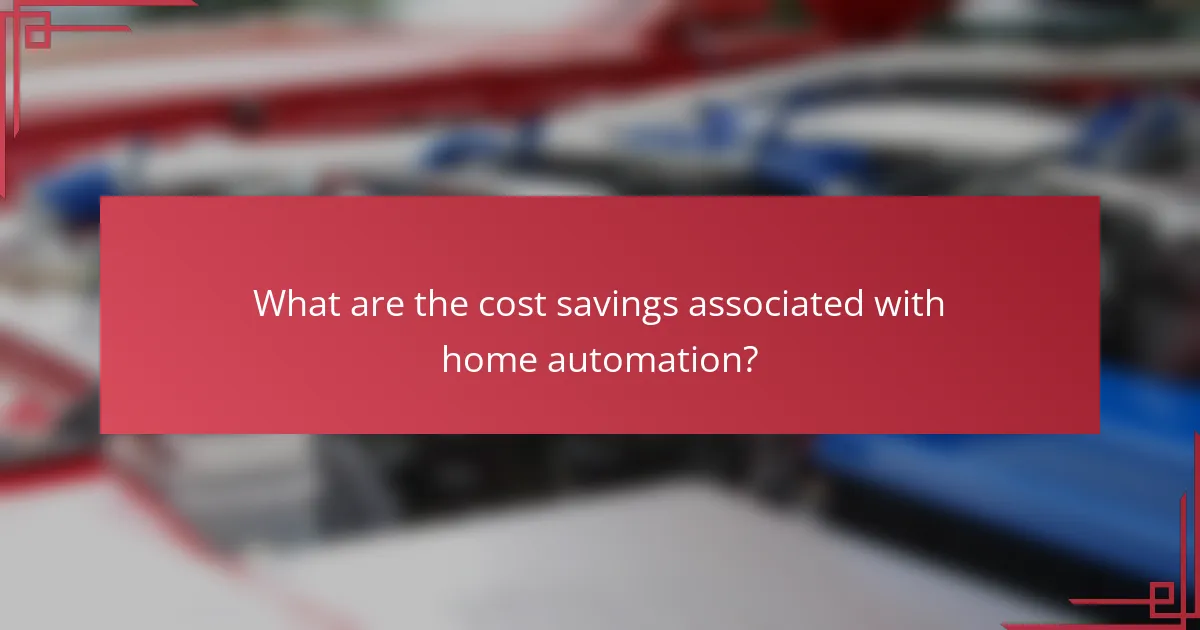
What are the cost savings associated with home automation?
Home automation can lead to significant cost savings by enhancing energy efficiency, reducing utility bills, and increasing property value. By integrating smart technology, homeowners can optimize their energy use and take advantage of various financial incentives.
Lower utility bills through optimized energy use
Smart home systems can automatically adjust heating, cooling, and lighting based on occupancy and time of day, leading to lower utility bills. For instance, programmable thermostats can save homeowners around 10-15% on heating and cooling costs by adjusting temperatures when no one is home.
Additionally, smart appliances can operate during off-peak hours when electricity rates are lower, further reducing energy expenses. Homeowners should consider investing in energy-efficient devices that are compatible with automation systems to maximize savings.
Increased property value with smart features
Homes equipped with smart technology often see an increase in property value, as buyers are increasingly looking for energy-efficient and convenient features. Properties with automated systems can sell for 5-10% more than similar homes without such upgrades.
Investing in smart home technology not only enhances comfort but also makes a property more attractive in a competitive real estate market. Features like smart security systems, automated lighting, and energy management tools can be strong selling points.
Tax incentives for energy-efficient upgrades
Many governments offer tax incentives for homeowners who invest in energy-efficient upgrades, including smart home technology. In the U.S., for example, homeowners can benefit from federal tax credits for certain energy-efficient improvements, which can cover a portion of the installation costs.
Homeowners should research local and federal programs to identify available incentives. Keeping documentation of purchases and installations can help maximize potential savings when filing taxes.
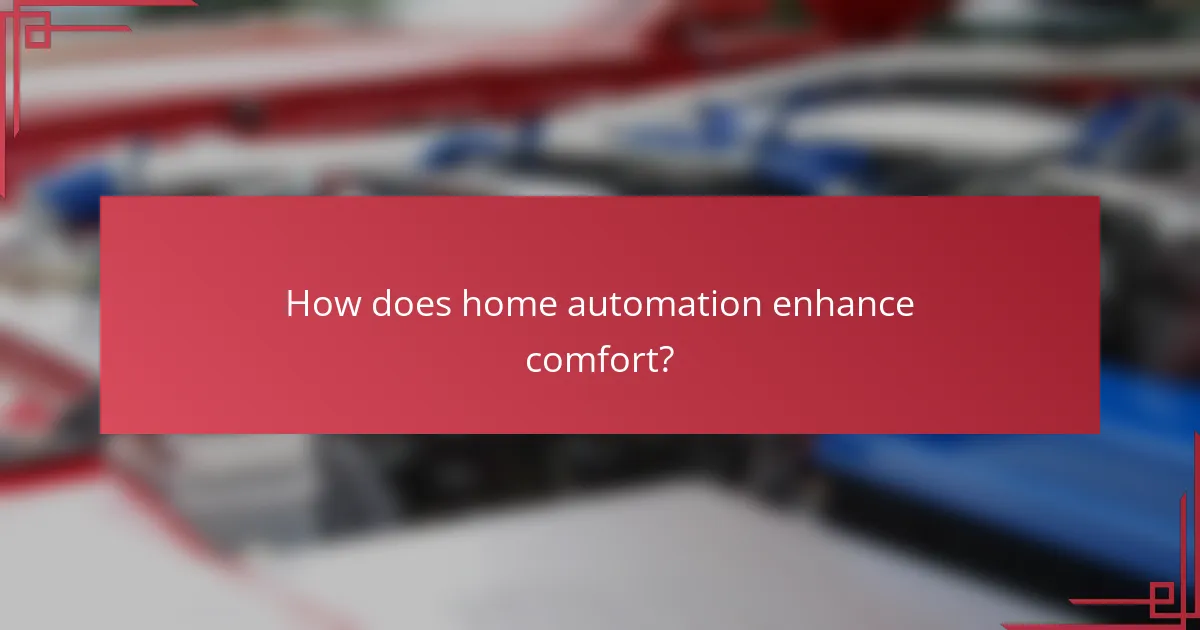
How does home automation enhance comfort?
Home automation enhances comfort by allowing users to customize their living environments through technology. This includes adjusting temperature, lighting, and security systems to create a more enjoyable and convenient atmosphere.
Personalized climate control settings
Personalized climate control settings enable homeowners to maintain their preferred temperature throughout the day. Smart thermostats can learn your schedule and adjust heating or cooling automatically, optimizing comfort while saving energy.
For instance, you can set your thermostat to lower the temperature during the night and raise it before you wake up, ensuring a comfortable environment without wasting energy. Many systems allow for easy adjustments via smartphone apps, making it simple to change settings on the go.
Remote access for convenience
Remote access provides the ability to control home systems from anywhere, enhancing convenience and comfort. With mobile apps, homeowners can adjust heating, cooling, and lighting even when they are not at home.
This feature is particularly useful for ensuring that your home is at a comfortable temperature upon arrival. For example, you can turn on the air conditioning while you’re still at work, so your home is cool when you get back.
Integration with smart home devices
Integration with smart home devices allows for a seamless experience in managing various aspects of your home. Devices such as smart lights, security cameras, and voice assistants can work together to enhance comfort and security.
For example, you can set your smart lights to adjust automatically based on the time of day or your activities. Additionally, voice commands can control multiple devices at once, such as dimming lights and adjusting the thermostat with a single phrase, making daily routines more efficient.

What are the best home automation systems available in Ireland?
The best home automation systems in Ireland include Google Nest, Amazon Echo, and Philips Hue, each offering unique features that enhance energy efficiency, cost savings, and comfort. These systems allow users to control various aspects of their homes through smart technology, improving convenience and reducing energy consumption.
Google Nest for comprehensive control
Google Nest provides a robust home automation solution that integrates various devices, including thermostats, cameras, and speakers. Its compatibility with numerous smart devices allows for centralized control through the Google Home app, making it easy to manage your home environment from anywhere.
One of the key advantages of Google Nest is its energy-saving features, such as the Nest Learning Thermostat, which adjusts heating and cooling based on your habits. This can lead to significant savings on energy bills over time, often reducing costs by around 10-15%.
Amazon Echo for voice-activated convenience
Amazon Echo, powered by Alexa, offers a hands-free approach to home automation. Users can control compatible devices using voice commands, making it simple to adjust lighting, temperature, and security systems without needing a smartphone or remote.
Echo devices can also serve as hubs for various smart home products, allowing for seamless integration. This system is particularly beneficial for those who prefer a more intuitive and accessible way to manage their home, enhancing comfort and convenience.
Philips Hue for customizable lighting
Philips Hue is a leading smart lighting system that allows users to customize their home lighting experience. With a wide range of bulbs and fixtures, Philips Hue enables you to create different moods and settings, all controllable via a smartphone app or voice commands through compatible devices.
This system not only enhances comfort but also contributes to energy efficiency, as you can schedule lights to turn off when not in use. Additionally, Philips Hue lights can be set to mimic natural daylight, which can improve well-being and productivity at home.
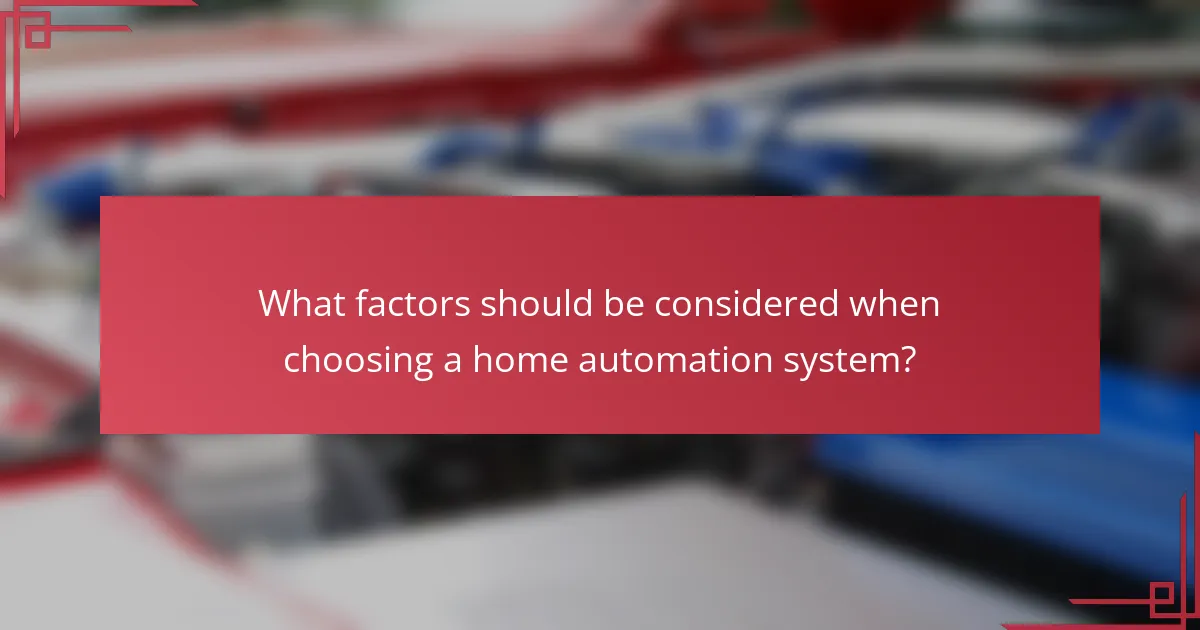
What factors should be considered when choosing a home automation system?
When selecting a home automation system, consider compatibility with existing devices, scalability for future upgrades, and user interface ease of use. These factors will ensure that your system meets current needs while allowing for growth and is user-friendly for all household members.
Compatibility with existing devices
Compatibility is crucial when choosing a home automation system, as it determines how well new devices can integrate with your current setup. Look for systems that support a wide range of protocols like Zigbee, Z-Wave, or Wi-Fi to ensure seamless communication between devices. Checking manufacturer specifications and user reviews can help identify potential compatibility issues.
For example, if you already have smart bulbs, thermostats, or security cameras, ensure the new system can control these devices without requiring extensive modifications. This can save time and money on replacements or additional adapters.
Scalability for future upgrades
Scalability refers to the ability of your home automation system to expand as your needs change. Choose a system that allows for easy addition of new devices or features without requiring a complete overhaul. This flexibility is essential for adapting to advancements in technology or changes in household requirements.
Consider systems that offer modular options or cloud-based services, which can provide updates and new functionalities over time. This way, you can gradually enhance your home automation without significant upfront costs.
User interface and ease of use
The user interface of a home automation system should be intuitive and accessible for all users, regardless of their tech-savviness. A well-designed app or control panel can significantly enhance the user experience, making it easier to manage devices and settings. Look for systems that offer customizable dashboards and voice control options for added convenience.
Testing the interface before purchase can help identify any usability issues. Consider systems that provide a demo or trial period, allowing you to assess whether the interface meets your needs effectively. A user-friendly system can lead to higher satisfaction and more consistent use of home automation features.

What are the prerequisites for implementing home automation?
To implement home automation effectively, you need a reliable internet connection, an understanding of how smart devices integrate, and a budget for initial setup costs. These prerequisites ensure that your system operates smoothly and meets your needs.
Reliable internet connection
A stable internet connection is essential for home automation systems to function properly. Most smart devices rely on Wi-Fi to communicate with each other and with your smartphone or control hub.
Consider a broadband connection with speeds of at least 25 Mbps for optimal performance. If you have multiple devices, you may need to upgrade to a higher speed plan to avoid lag and ensure seamless operation.
Understanding of smart device integration
Familiarity with how smart devices integrate is crucial for a successful home automation setup. Different devices may use various protocols such as Zigbee, Z-Wave, or Wi-Fi, and knowing how they work together can prevent compatibility issues.
Research the devices you plan to use and ensure they can communicate with your chosen hub or platform. Look for devices that support common standards to simplify integration and expand your system in the future.
Budget for initial setup costs
Setting up a home automation system requires a budget for initial costs, which can vary widely based on the devices and technology you choose. Basic systems may start in the low hundreds of USD, while more advanced setups can reach thousands.
Consider not only the cost of devices but also installation fees, if applicable, and any subscription services for monitoring or additional features. Planning your budget carefully will help you avoid overspending and ensure you get the most value from your investment.
